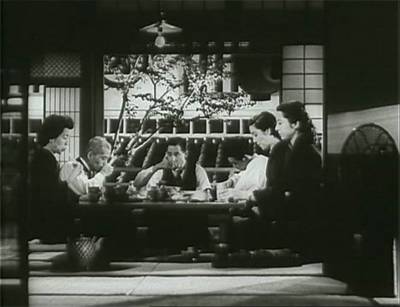Ozu, Tokyo Story, etc.

Scene from Yasujiro Ozu's Tokyo monogatari (Tokyo Story, 1953).
What would a new film done in the style of Ozu’s Tokyo Story look like? It would have an unusual mood. If the way people spoke and acted was the same, and their expressions were the same, the interesting graphic relations between shots, the low camera angles close to the floor, its pacing, and confusing 360 degree camera angles.
A good film idea would be to mix Tokyo Story’s story of a neglected parent who passes away, with a murder or political suspense.
Could Ozu’s style ever allow for fast action? Can fast action be effectively placed into an Ozu type of film for drastic and contrasting dramatic effect? Or is it the opposite -- fast action doesn’t fit into his style.
A documentary film can become a “great” film, and even a great artistic film, if is places an individual instance (which is what the film is about) into a great theme or universal problem, especially when the individual instance is portrayed as part of a recurring issue, part of the evolution/development of the problem.
A film’s sound track can tell you about the film maker -- if it is made by an old fogy (jazz or ‘Adult Contemporary’ soundtrack) or by someone trying to be cool (the latest thrash/punk in the alternative top 40).
A good way to build suspense in film -- by teh use of film technique that creates unrestricted narration (knowledge of the story beyond what the character knows) like when we view through the eyes of someone following the character (a POV, point of view shot). The character may be sitting or walking along minding their own business, and the camera follows them, maybe peering around a corner. This is a good way to start building suspense, to make the viewer aware that something sinister may be going on, after the previous scenes have looked like everything was normal.

0 Comments:
Post a Comment
<< Home